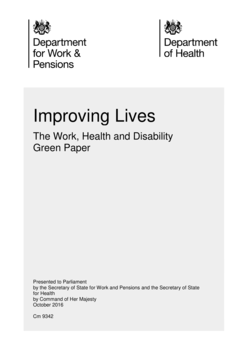Hello! You're looking at a policy document report on Overton
We track government policy, guidelines, think tank research, working papers and more to help our customers see the impact and influence of their work. Are you interested in seeing what information we have to offer? Request a free trial to our platform.
If you fund, produce or manage research or work to influence policy, we'd love to talk. Learn more on our homepage.

Work, health and disability: improving lives
Work, health and disability: improving lives
Topics in this document
Related SDGs
Target 3.4
Reduce by one third premature mortality from non-communicable diseases through prevention and treatment and promote mental health and well-being
Target 3.8
Achieve universal health coverage, including financial risk protection, access to quality essential health-care services and access to safe, effective, quality and affordable essential medicines and vaccines for all
Target 8.5
Achieve full and productive employment and decent work for all women and men, including for young people and persons with disabilities, and equal pay for work of equal value
Target 8.8
Protect labour rights and promote safe and secure working environments for all workers, including migrant workers, in particular women migrants, and those in precarious employment
Target 10.2
Empower and promote the social, economic and political inclusion of all, irrespective of age, sex, disability, race, ethnicity, origin, religion or economic or other status
Cites research funded by
Citations
Rights & Permissions
Uses license: Open Government Licence
Content from GOV.UK is subject to Crown copyright protection and is published under the Open Government Licence (OGL)

This document is made up of multiple PDFs
The references found in each have been combined below. If an item has been cited in more than one PDF then it'll appear more than once, linked to the relevant PDF and page number.
